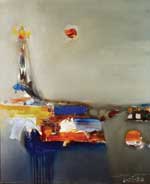Each in Their Own Voice: African-American Artists in Cleveland, 1970-2005
Al Bright interview excerpt, 28 October 2008
Instructions for controlling the program with a keyboard.

Please note that Flash Player 10 (or higher) OR an HTML 5 compatible browser as well as JavaScript is required to play this recording. If you experience problems, please check your version of Flash or update to a more current browser and make sure JavaScript is enabled.
Program Length: 04:07
Al Bright has been driven since childhood by his art, "a force inside him." He describes a childhood incident with racism, which taught him the feeling of "nothingness." The incident did not leave him hating white people, but did lead him to read philosophy, which has influenced his art. Bright won Junior Achievement award in high school, met CEO Ed Mosler who encouraged him to go to college and helped him attend the University of Youngstown.
Bright came from a very musically creative family, and incorporates music with performance art. In graduate school he created a "walk-in" environment, designed to stimulate all the senses, two young women had a psychotic incident while in the room. Bright has moved on from this type of work. Bright describes his experiments with surrealistic paintings that incorporated Michelangelo's David. Bright began teaching right out of graduate school, he thinks teaching and doing art are linked, teaching allowed him to paint with a stronger sense of content, he would teach all day and paint all night.
Bright sees all of his work as sequential, his greatest work is his life. He is very proud of his improvisational art, created in conjunction with live music, in front of an audience. He has worked with all types of musicians, from jazz to classical. As first black art professor at Youngstown he was asked to head Black Studies program, he feels that only African-American artists are asked if their race influences their art. Bright does not think about himself as black, but as a humanist and a human being. Blacks are not a monolithic culture. Bight relates his process, and how creating art in front of an audience is a tribal process, similar to primitive societies where artists and musicians are not separated from other members of society.
Rights: Organizations and individuals seeking to use materials for public exhibition and/or commercial use must obtain permission from the History Department of Cleveland State University. Use of materials for educational and research purposes is considered fair use.






